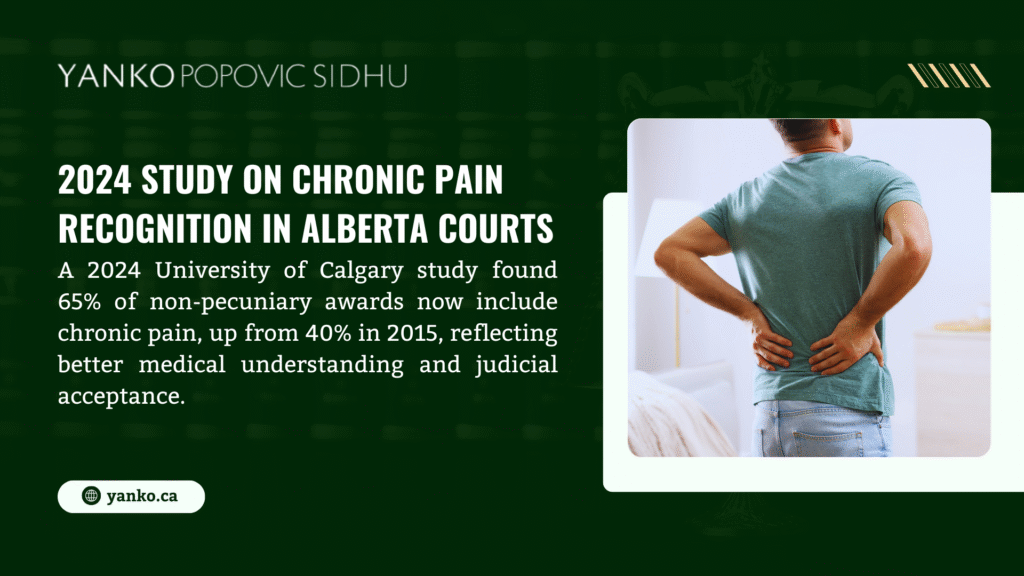Article Summary
- Non pecuniary damages compensate for pain, suffering, and loss of life enjoyment in Alberta injury cases
- Current Alberta awards range from $5,000 for minor injuries to $420,000+ for catastrophic cases in 2025
- The Supreme Court of Canada cap applies to awards exceeding $420,000 for non-pecuniary damages
- Factors include injury severity, age, pre-accident lifestyle, and long-term impact on daily activities
- Calgary courts consistently award higher amounts than rural Alberta jurisdictions for similar injuries
- Medical evidence, expert testimony, and detailed documentation significantly impact award amounts
- Most non-pecuniary damages examples in Alberta settle between $15,000 and $150,000 for moderate injuries
Non pecuniary damages represent the money courts award for intangible losses that accident victims experience. Unlike medical bills or lost wages, these damages compensate for pain, suffering, and how injuries change your quality of life.
In Alberta, non-pecuniary damages examples show awards ranging from a few thousand dollars to over $420,000, depending on injury severity. The province follows established legal principles that help determine appropriate compensation amounts for different types of harm.
Calgary’s Court of Queen’s Bench has handled thousands of personal injury cases over the past decade. These cases provide clear examples of how Alberta courts calculate non-pecuniary damages for various injury types and circumstances.
What Are Non-Pecuniary Damages in Alberta
Non pecuniary damages compensate injury victims for losses that cannot be easily calculated in dollars. These awards recognize that some consequences of accidents go beyond financial costs.
Alberta law recognizes several categories of non-pecuniary damages. Pain and suffering form the largest component. But courts also consider loss of amenities, shortened life expectancy, and psychological trauma when calculating awards.
The legal system tries to put a dollar value on experiences that naturally resist quantification. How much is chronic pain worth? What about the inability to play sports or enjoy hobbies? Alberta courts use established precedents to answer these difficult questions.
Key Components of Nonpecuniary Damages:
| Damage Type | Description | Typical Impact on Award |
| Pain and Suffering | Physical discomfort and emotional distress | 60-70% of the total award |
| Loss of Amenities | Cannot enjoy previous activities | 20-25% of the total award |
| Shortened Life Expectancy | Reduced lifespan due to injuries | 10-15% of the total award |
| Psychological Impact | Depression, anxiety, PTSD | Variable, case-specific |
The Supreme Court of Canada established guidelines that limit non-pecuniary awards. The current maximum is approximately $420,000 in 2025 dollars. This cap applies to the most catastrophic injuries involving young victims with severe, permanent disabilities.
Alberta courts regularly award amounts well below this maximum. Most cases involve moderate injuries with awards between $15,000 and $100,000. The specific amount depends on how the injury affects each person’s unique circumstances.
Non-Pecuniary Damages Examples by Injury Type
Real Alberta court cases provide the best examples of how judges calculate non-pecuniary damages. These cases show the factors that increase or decrease awards for different injury types.
Soft Tissue Injuries
Minor soft tissue injuries typically receive the lowest nonpecuniary awards in Alberta. These cases involve muscle strains, ligament sprains, and minor whiplash injuries that heal within 6-18 months.
Recent Alberta Soft Tissue Awards:
| Case Details | Award Amount | Key Factors |
| 32-year-old Calgary teacher, mild whiplash | $8,500 | Full recovery in 8 months |
| 45-year-old Edmonton mechanic, neck strain | $12,000 | Some ongoing stiffness |
| 28-year-old nurse, shoulder injury | $15,500 | Career impact, 18-month recovery |
Courts consider recovery time, age, and pre-accident activity levels when assessing soft tissue cases. Younger plaintiffs often receive slightly higher awards because they have more years to experience the injury’s effects.
Fracture Injuries
Broken bones typically result in higher nonpecuniary awards than soft tissue injuries. The location, complexity, and healing complications significantly affect the final amount.
Recent Alberta Fracture Awards:
| Fracture Type | Award Range | Complications |
| Simple arm fracture | $18,000 – $35,000 | Healing time, scarring |
| Complex leg fracture | $45,000 – $85,000 | Surgery, permanent hardware |
| Facial fractures | $25,000 – $70,000 | Scarring, nerve damage |
| Spinal fractures | $60,000 – $200,000 | Mobility issues, chronic pain |
Complications like infection, hardware failure, or malunion typically increase awards by 25-50%. Courts also consider visible scarring, especially on exposed body parts, when calculating appropriate compensation.

Traumatic Brain Injuries
Brain injuries produce some of the highest nonpecuniary awards in Alberta. Even mild traumatic brain injuries can result in significant compensation due to their potential for long-term cognitive effects.
Alberta Brain Injury Award Examples:
| Severity Level | Typical Award Range | Common Symptoms |
| Mild TBI | $75,000 – $150,000 | Memory problems, headaches |
| Moderate TBI | $200,000 – $350,000 | Personality changes, seizures |
| Severe TBI | $350,000 – $420,000+ | Cognitive disability, care needs |
Brain injury cases require extensive medical evidence and neuropsychological testing. Courts rely heavily on expert testimony to understand the injury’s impact on cognitive function, emotional regulation, and quality of life.
Spinal Cord Injuries
Spinal cord injuries often result in the maximum nonpecuniary awards allowed under Alberta law. These cases involve partial or complete paralysis with devastating effects on all aspects of life.
Recent Alberta Spinal Injury Awards:
| Injury Level | Award Amount | Functional Impact |
| Incomplete T12 injury | $275,000 | Partial leg weakness |
| Complete L1 injury | $340,000 | Wheelchair dependent |
| Incomplete C6 injury | $395,000 | Limited arm function |
| Complete C4 injury | $420,000 | Ventilator dependent |
Spinal cord cases often reach the Supreme Court cap because they involve young victims with permanent, life-altering disabilities. Courts consider the plaintiff’s pre-accident activities, career plans, and family relationships when assessing the full impact.
Factors That Affect Non-Pecuniary Awards in Alberta
Alberta courts examine multiple factors when determining appropriate non-pecuniary awards. These factors help ensure compensation reflects each plaintiff’s unique circumstances and injury impact.
Age at Time of Injury
Age significantly influences non-pecuniary awards in Alberta. Younger plaintiffs typically receive higher amounts because they must live with their injuries for more years.
Age Impact on Awards:
| Age Group | Award Multiplier | Reasoning |
| Under 30 | 1.2x – 1.4x base award | Decades of impact ahead |
| 30-50 years | 1.0x base award | Standard calculation |
| 50-65 years | 0.8x – 0.9x base award | Fewer active years affected |
| Over 65 | 0.6x – 0.8x base award | Limited life expectancy |
Courts also consider life stage factors. A young parent unable to participate in children’s activities may receive more compensation than a single person with fewer family responsibilities.
Pre-Accident Lifestyle and Activities
Active individuals who lose the ability to pursue sports, hobbies, or recreational activities typically receive higher nonpecuniary awards. Courts carefully examine what activities the injury prevents.
Lifestyle Factor Examples:
| Activity Type | Potential Award Increase | Evidence Required |
| Competitive athletics | 15-25% | Competition records, team rosters |
| Outdoor recreation | 10-20% | Photos, equipment purchases |
| Musical performance | 15-30% | Performance history, recordings |
| Physical labor hobbies | 10-15% | Project documentation, photos |
Courts require concrete evidence of pre-accident activities. Photos, videos, competition results, and witness testimony help establish what the plaintiff actually did rather than claimed to do.
Geographic Variations Within Alberta
Non pecuniary awards can vary between different Alberta courts. Calgary and Edmonton typically award higher amounts than smaller centers for similar injury cases.
Regional Award Patterns:
| Court Location | Average Award Premium | Possible Factors |
| Calgary | +8% to 12% above provincial average | Higher living costs, urban lifestyle |
| Edmonton | +5% to 10% above provincial average | Large plaintiff bar, precedent-setting |
| Red Deer | Provincial average | Mixed urban-rural jurisdiction |
| Lethbridge | -3% to 5% below average | More conservative approach |
| Rural courts | -5% to 10% below average | Traditional values, cost considerations |
This geographic variation reflects different judicial attitudes and local economic conditions. Urban courts may better appreciate the financial and lifestyle costs of living with injuries in major cities.
However, appellate courts work to minimize these variations. The Alberta Court of Appeal regularly reviews awards to ensure consistency across the province.
Medical Evidence and Documentation Requirements
Strong medical evidence forms the foundation of successful non-pecuniary damage claims in Alberta. Courts rely heavily on objective medical findings and expert opinions when calculating appropriate awards.
Essential Medical Documentation
Complete medical records from all treating physicians provide the basic evidence for non-pecuniary claims. These records must clearly document the injury’s progression and treatment response.
Required Medical Evidence:
| Document Type | Purpose | Impact on Award |
| Emergency room records | Establish immediate injury | Baseline for injury severity |
| Diagnostic imaging | Objective injury confirmation | Supports claimed limitations |
| Treatment notes | Document ongoing symptoms | Shows injury persistence |
| Specialist reports | Expert medical opinions | Validates treatment needs |
Courts expect plaintiffs to follow reasonable treatment recommendations. Failure to pursue suggested treatments, especially for psychological injuries, can reduce non-pecuniary awards substantially.
Expert Medical Testimony
Complex injury cases require expert medical witnesses to explain the injury’s impact on the plaintiff’s life. These experts help courts understand technical medical issues and long-term prognosis.
Types of Medical Experts:
| Expert Type | Typical Cost | When Required |
| Orthopedic surgeon | $3,000 – $5,000 | Bone and joint injuries |
| Neurologist | $4,000 – $7,000 | Brain and nerve damage |
| Psychiatrist | $3,500 – $6,000 | Psychological injuries |
| Physiatrist | $3,000 – $5,000 | Rehabilitation medicine |
Expert reports must address functional limitations rather than just medical diagnoses. Courts want to understand how injuries actually affect the plaintiff’s ability to work, sleep, exercise, and enjoy life.
Pain and Suffering Calculations in 2025
Alberta courts use established methods to calculate pain and suffering awards. These methods help ensure consistency while allowing for individual case variations.
Current Award Ranges by Severity
The Alberta Courts maintain informal guidelines for pain and suffering awards based on injury severity and duration. These ranges reflect 2025 dollar values adjusted for inflation.
2025 Pain and Suffering Guidelines:
| Injury Category | Award Range | Typical Duration |
| Minor temporary | $5,000 – $20,000 | Under 12 months |
| Moderate temporary | $20,000 – $60,000 | 1-3 years |
| Moderate permanent | $60,000 – $120,000 | 3+ years with limitations |
| Severe permanent | $120,000 – $250,000 | Significant disability |
| Catastrophic | $250,000 – $420,000 | Life-altering injuries |
These ranges provide starting points for negotiations and court decisions. Individual factors can push awards above or below these typical amounts.
Inflation Adjustments and Trends
Non pecuniary awards in Alberta have increased approximately 15% over the past five years to account for inflation and changing social attitudes about compensation for intangible losses.
Recent Award Trends:
| Year | Average Award Increase | Key Factors |
| 2021 | +2.3% | Moderate inflation |
| 2022 | +4.1% | Higher inflation rates |
| 2023 | +3.8% | Continued economic pressure |
| 2024 | +2.9% | Stabilizing inflation |
| 2025 | +2.1% (projected) | Economic normalization |
Courts also show increased recognition of psychological injuries and chronic pain conditions. Awards for these conditions have increased faster than inflation as medical understanding improves.
Mental health injuries now receive more serious consideration in Alberta courts. The stigma that previously reduced psychological injury awards has largely disappeared in urban jurisdictions.
How Nonpecuniary Damages Fit Into Total Compensation
Non pecuniary damages represent just one component of total injury compensation in Alberta. Understanding how these awards work with other damage types helps plaintiffs make informed settlement decisions.
Breakdown of Typical Settlements
Most Alberta personal injury settlements include multiple damage categories. Non pecuniary damages typically represent 25-40% of total compensation for moderate to severe injuries.
Typical Settlement Composition:
| Damage Type | Percentage of Total | Purpose |
| Medical expenses | 15-25% | Past and future treatment |
| Lost income | 30-45% | Past and future earnings |
| Non pecuniary | 25-40% | Pain, suffering, loss of amenities |
| Special expenses | 5-15% | Care, equipment, modifications |
Younger plaintiffs typically see higher percentages for future income losses. Older plaintiffs often have proportionally higher non-pecuniary awards since their remaining earning years are limited.

Tax Implications
Non pecuniary damage awards receive favorable tax treatment in Canada. These amounts are not taxable income, unlike employment earnings or most investment returns.
Tax Treatment Summary:
| Award Component | Tax Status | Benefit |
| Non pecuniary damages | Tax-free | Full award retained |
| Past income loss | Tax-free | Replaces after-tax earnings |
| Future income loss | Tax-free | Higher effective value |
| Medical expenses | Tax-free | No additional tax burden |
This tax advantage makes non-pecuniary awards particularly valuable. A $100,000 award provides the same benefit as earning approximately $140,000 in employment income for most Albertans.
Courts consider this tax advantage when calculating appropriate award amounts. The tax-free nature partly justifies lower award amounts compared to what plaintiffs might earn through work.
Negotiation Strategies for Non-Pecuniary Claims
Successful negotiation of non-pecuniary damages requires specific strategies that address the subjective nature of these claims. Insurance companies often challenge these awards more aggressively than concrete financial losses.
Building a Strong Non-Pecuniary Case
Documentation forms the cornerstone of effective non-pecuniary claims. Detailed records of how injuries affect daily life provide concrete evidence for intangible losses.
Essential Documentation:
| Evidence Type | Collection Method | Legal Impact |
| Pain diaries | Daily symptom tracking | Shows consistency and severity |
| Activity limitations | Before/after comparisons | Demonstrates specific losses |
| Family impact statements | Witness affidavits | Provides a third-party perspective |
| Photographic evidence | Regular documentation | Visual proof of limitations |
Video documentation can be particularly powerful. Day-in-the-life videos showing the plaintiff’s struggles with basic activities often convince insurance adjusters to increase settlement offers significantly.
Common Insurance Company Tactics
Insurance companies use predictable strategies to minimize nonpecuniary awards. Recognition of these tactics helps plaintiffs and their lawyers respond effectively.
Typical Defense Strategies:
| Tactic | Purpose | Counter-Strategy |
| Surveillance | Find inconsistent activities | Maintain honest activity levels |
| Medical examinations | Get favorable medical opinions | Prepare thoroughly, be honest |
| Social media monitoring | Discover contradictory evidence | Limit posting, review privacy settings |
| Quick settlement offers | Avoid a full injury assessment | Wait for the complete medical picture |
Honesty remains the best policy throughout the claims process. Exaggerated claims often backfire spectacularly when discovered, destroying the plaintiff’s credibility on all issues.
Recent Legal Developments Affecting Awards
Alberta’s approach to non-pecuniary damages continues evolving through new court decisions and legislative changes. Recent developments affect how courts calculate and award these damages.
Legislative and Regulatory Changes
The Alberta government has made several changes affecting personal injury claims in 2024-2025. These changes primarily impact the claims process rather than award calculations.
Recent Regulatory Updates:
| Change | Effective Date | Impact |
| Medical examination limits | January 2024 | Reduced defense medical exams |
| Expert report timelines | March 2024 | Faster case resolution |
| Settlement conference requirements | June 2024 | Mandatory early discussions |
These changes generally benefit injury claimants by reducing costs and speeding resolution. Fewer defense medical examinations mean less harassment of injured plaintiffs.
The mandatory settlement conferences have increased resolution rates. Many cases settle earlier with fair non-pecuniary awards rather than proceeding to expensive trials.
When to Accept vs. Reject Settlement Offers
Deciding whether to accept a settlement offer for non-pecuniary damages requires careful analysis of multiple factors. The timing and terms of offers significantly affect this decision.
Evaluation Criteria
Several factors help determine whether a non-pecuniary settlement offer is fair and reasonable. Comparison with similar Alberta cases provides the primary benchmark.
Settlement Evaluation Factors:
| Factor | Weight | Consideration |
| Comparable case awards | High | Similar injuries and circumstances |
| Injury progression | High | Stable vs. deteriorating condition |
| Litigation costs | Medium | Legal fees and expenses |
| Time to trial | Medium | Delay costs and risks |
| Strength of evidence | High | Medical support and documentation |
Early offers are typically low because insurers hope to resolve claims before full injury assessment. Accepting early offers often means leaving substantial money on the table.
Red Flags in Settlement Offers
Certain settlement offer characteristics suggest lowball amounts that warrant rejection. Recognition of these red flags helps protect claimants from inadequate compensation.
Warning Signs:
| Red Flag | Implication | Response |
| Extremely quick offer | Insurer fears higher liability | Investigate thoroughly |
| Below comparable awards | Inadequate research or bad faith | Demand justification |
| Pressure for immediate acceptance | The insurer knows the offer is low | Take time to evaluate |
| No medical expense coverage | Incomplete assessment | Require full cost analysis |
Legitimate settlement offers include detailed justification and a reasonable time for consideration. Pressure tactics often indicate the insurer knows its offer is inadequate.
Working with experienced Alberta personal injury lawyers helps identify fair settlement ranges and negotiation strategies for non-pecuniary claims.
For comprehensive guidance on personal injury settlements in Alberta, our detailed settlement guide at https://www.yanko.ca/personal-injury-settlement/ covers all aspects of the negotiation process.
Maximizing Your Nonpecuniary Damage Award
Strategic approaches can significantly increase non-pecuniary damage awards in Alberta personal injury cases. These strategies require early planning and consistent implementation throughout the claims process.
Professional Support and Treatment
Consistent medical treatment and professional support strengthen non-pecuniary claims. Courts view treatment compliance as evidence of injury severity and genuine suffering.
Professional Support Team:
| Professional | Role | Impact on Award |
| Family physician | Primary care and referrals | Establishes injury baseline |
| Physiotherapist | Pain management and mobility | Documents functional limitations |
| Psychologist | Mental health support | Addresses psychological impact |
| Occupational therapist | Daily living assistance | Proves activity restrictions |
Activity and Limitation Documentation
Detailed documentation of activity limitations provides concrete evidence for non-pecuniary claims. This documentation helps courts understand how injuries actually affect daily life.
Documentation Strategies:
| Method | Frequency | Legal Value |
| Daily activity log | Daily entries | Shows consistency |
| Photo documentation | Weekly photos | Visual evidence |
| Family statements | Monthly updates | Third-party verification |
| Video recording | As needed | Powerful visual impact |
Day-in-the-life videos have become particularly effective in Alberta courts. These videos show the plaintiff’s actual limitations rather than simply describing them.
Professional videographers can create compelling presentations. But even smartphone videos provide valuable evidence if they honestly portray the plaintiff’s daily struggles.
Timing Considerations
The timing of settlement negotiations affects non-pecuniary damage awards. Premature settlement often results in inadequate compensation for long-term consequences.
Optimal Timing Guidelines:
| Injury Type | Minimum Wait Period | Reasoning |
| Soft tissue | 12-18 months | Allow full recovery assessment |
| Fractures | 18-24 months | Monitor healing complications |
| Brain injuries | 24-36 months | Neurological recovery plateaus |
| Spinal injuries | 36+ months | Maximum medical improvement |
Most personal injury lawyers recommend waiting until maximum medical improvement before serious settlement discussions. This ensures full assessment of long-term consequences and appropriate compensation.
Early settlement may be appropriate for clearly minor injuries with an excellent prognosis. But complex cases benefit from a patient, thorough development of all evidence.
When you’re facing the challenge of documenting and proving non-pecuniary damages, having experienced legal representation makes a substantial difference. Yanko Popovic Sidhu has successfully recovered millions in non-pecuniary damages for Alberta injury victims over more than 40 years of practice.
Our team knows how to present compelling evidence of pain, suffering, and loss of life enjoyment that resonates with judges and insurance adjusters. We work with top medical experts and use advanced documentation techniques to maximize your compensation.
Contact Yanko Popovic Sidhu today for a free consultation about your non pecuniary damage claim. We’ll evaluate your case and explain how to build the strongest possible claim for fair compensation.

Frequently Asked Questions About Non Pecuniary Damages in Alberta
Q: What is the maximum amount for non-pecuniary damages in Alberta in 2025?
A: The current maximum for non-pecuniary damages in Alberta is approximately $420,000 in 2025. This cap applies only to the most catastrophic cases involving young victims with severe, permanent disabilities. The Supreme Court of Canada established this limit, which increases annually with inflation. Most cases receive significantly less than this maximum amount.
Q: How long do I have to claim non-pecuniary damages after an accident in Alberta?
A: You have two years from the date of the accident to file a personal injury lawsuit in Alberta. This limitation period applies to all damages, including non-pecuniary claims. In some cases involving delayed discovery of injuries, the two-year period may start when you knew or should have known about the injury and its connection to the accident.
Q: Can I get non-pecuniary damages if I was partially at fault for the accident?
A: Yes, but your award will be reduced by your percentage of fault. Alberta follows comparative negligence rules. If you’re found 30% at fault for an accident, your non-pecuniary damages will be reduced by 30%. For example, if your pain and suffering award would have been $50,000, you would receive $35,000 after the reduction.
Q: Do I need a lawyer to claim non-pecuniary damages in Alberta?
A: While not legally required, having a lawyer significantly improves your chances of receiving fair non-pecuniary damages. These claims involve complex medical evidence and legal precedents that require specialized knowledge. Insurance companies often challenge non-pecuniary claims aggressively because they’re subjective. Experienced lawyers know how to present compelling evidence and negotiate effectively.
Q: How are non-pecuniary damages different from pain and suffering compensation?
A: Pain and suffering are actually a component of nonpecuniary damages. Non pecuniary damages include pain and suffering plus loss of amenities, shortened life expectancy, and loss of enjoyment of life. Pain and suffering typically represent 60-70% of the total non-pecuniary award, with other factors making up the remainder.
Q: Will my non-pecuniary damage award be taxed in Alberta?
A: No, non-pecuniary damage awards are not taxable income in Canada. This tax-free status makes these awards particularly valuable compared to employment income. You keep the entire amount without any tax deductions, unlike wages or salary, which face income tax.
Q: How do Calgary courts compare to other Alberta cities for non-pecuniary awards?
A: Calgary courts typically award 8-12% more than the provincial average for similar injuries. Edmonton awards are 5-10% above average. Rural Alberta courts tend to be more conservative, awarding 5-10% below provincial averages. These variations reflect different judicial attitudes and local economic conditions.
Q: What medical evidence do I need for a strong non-pecuniary damage claim?
A: You need complete medical records from all treating physicians, diagnostic imaging results, specialist reports, and treatment notes showing ongoing symptoms. Expert medical testimony is often crucial for complex cases. Gaps in treatment or failure to follow medical advice can significantly hurt your claim.
Q: How long does it take to resolve a non-pecuniary damage claim in Alberta?
A: Simple cases may resolve in 12-18 months, while complex cases can take 3-5 years. The timing depends on injury severity, medical treatment completion, and whether the case goes to trial. Most cases settle through negotiation rather than proceeding to a court trial.
Q: What activities should I avoid while pursuing non-pecuniary damages?
A: Be honest about your limitations, but don’t exaggerate them. Avoid activities that contradict your claimed restrictions. Insurance companies often conduct surveillance to catch inconsistent behavior. Social media posts showing activities you claim you cannot do will hurt your case. Maintain honest, consistent reporting of your capabilities and limitations.
Q: Can family members receive non-pecuniary damages for my injuries?
A: Family members may receive separate damages under Alberta’s Family Relief Act if your injuries significantly impact their lives. Spouses can claim loss of companionship and guidance. Children may receive compensation for loss of parental care and guidance. These are separate claims from your non-pecuniary damages.
For More:






